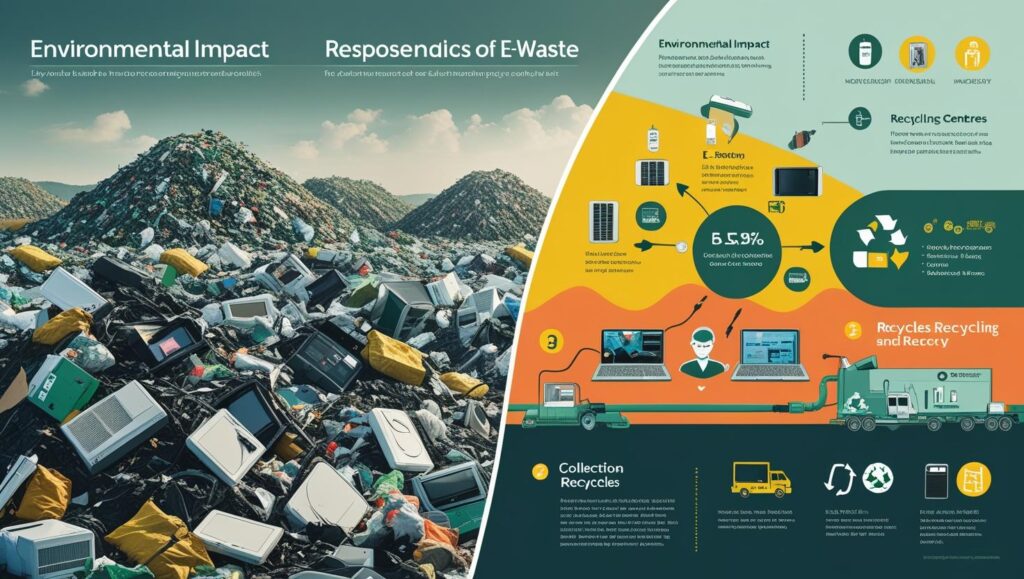In our modern, digital world, new gadgets arrive at an incredible pace. From smartphones and laptops to smart TVs and wearable tech, our lives are filled with electronics. But what happens to these devices when they reach the end of their useful life? The answer for many is a landfill, contributing to a global problem known as **e-waste**. This rapidly growing waste stream, also called electronic waste, is a serious threat to both our environment and our health. The good news is that we have the power to make a difference. By understanding the true impact of e-waste and learning how to properly dispose of our old devices, we can turn a harmful trend into a sustainable practice. This guide will walk you through the critical reasons why responsible disposal is so important and provide actionable steps on **how to recycle electronics** the right way.
Understanding the E-Waste Problem
E-waste is defined as any discarded product with a battery or plug. This includes everything from a broken toaster to an obsolete computer. The sheer volume of e-waste is staggering. A UN report revealed that a record 53.6 million metric tons of e-waste was generated globally in 2019, and less than 18% of it was formally recycled. This enormous amount of waste is a ticking time bomb, and it’s essential to understand why it’s so dangerous.
The Environmental and Health Consequences
The danger of e-waste lies in its toxic components. Many electronic devices contain hazardous materials that can leak into the environment when improperly disposed of. These include heavy metals and other harmful chemicals.
- Lead: Found in older CRT monitors and televisions, lead can damage the central nervous system and kidneys.
- Mercury: Used in fluorescent lamps and flat-screen monitors, mercury is a potent neurotoxin that can cause neurological and kidney damage.
- Cadmium: Found in rechargeable batteries and older monitors, cadmium can accumulate in the body and cause kidney disease.
- Brominated Flame Retardants (BFRs): Used in plastic casings and circuit boards, these chemicals can disrupt hormonal function.
When these devices are dumped in landfills, the toxic materials can leach into the soil and groundwater, contaminating our drinking water and food sources. Furthermore, in many parts of the world, e-waste is informally processed by burning, which releases toxic fumes and particulate matter into the air, leading to serious respiratory illnesses and other health issues for the workers and surrounding communities. The human cost is often invisible but no less devastating.
How to Recycle Electronics: A Step-by-Step Guide
Fortunately, there are simple and effective ways to ensure your old electronics don’t end up in a landfill. The key is to think beyond the garbage can and find a certified recycler. Following these steps will help you properly dispose of your devices and contribute to a more sustainable future. For more on this, consider checking out this internal link about how smart home devices can save you money.
Step 1: Data Security is a Priority
Before you do anything else, it’s crucial to wipe any personal data from your devices. Your old phone or computer contains sensitive information, from photos and emails to banking details. A simple factory reset might not be enough to fully erase the data, so it’s recommended to use data wiping software. For hard drives, physically destroying them is the most secure option. This step is vital to protect your privacy and prevent identity theft.
Step 2: Find a Certified E-Waste Recycler
Not all recyclers are created equal. You need to ensure you’re using a company that follows responsible recycling practices. Look for certifications such as R2 (Responsible Recycling) or e-Stewards. These certifications guarantee that the recycler adheres to strict environmental, health, and safety standards. They ensure that toxic materials are handled safely and that your device is processed in an environmentally friendly manner. A quick search on the R2 or e-Stewards website can help you find a certified facility near you.
Types of Recyclers and Collection Methods
You’ll find several options for recycling your electronics:
- Drop-off centers: Many municipalities and local waste management authorities have designated centers where you can drop off electronics for free or for a small fee.
- Retailer take-back programs: Major electronics retailers often have programs to accept old devices for recycling. This is a convenient option when you are purchasing a new device.
- Mail-in programs: Some manufacturers and recyclers offer free or low-cost shipping labels for you to mail in your old devices. This is a great option for smaller items like smartphones and tablets.
Step 3: Repurposing and Donating
Before recycling, consider if your device still has life left in it. If a device is still in working condition, consider donating it to a local school, library, or charity. Many non-profits can use older computers or phones to help those in need. This extends the life of the product and helps a worthy cause. For devices that are not quite functional but could be fixed, consider a local repair shop or hobbyist who might be able to repurpose the components. This circular approach is the most sustainable option of all.
The Economic and Social Benefits of E-Waste Recycling
Beyond the environmental benefits, recycling electronics also makes good economic sense. E-waste isn’t just trash; it’s a valuable resource. These devices contain precious metals like gold, silver, copper, and palladium, which can be extracted and reused. In fact, one metric ton of e-waste can contain up to 40-800 times more gold than a metric ton of gold ore.
| Resource | Amount in 1 Ton of E-Waste (approx.) | Comparison |
|---|---|---|
| Gold | 350 grams | ~40-800x more than gold ore |
| Silver | 2 kilograms | Valuable for electronics and jewelry |
| Copper | 150 kilograms | Essential for wiring and circuit boards |
| Palladium | 80 grams | Used in capacitors and connectors |
By recycling, we reduce the need for resource-intensive mining, which helps preserve natural habitats and lowers the carbon footprint associated with extraction and processing. Additionally, the e-waste recycling industry creates green jobs, supporting local economies and providing a safer, more sustainable alternative to informal and dangerous e-waste processing. The choice is clear: recycling isn’t just about waste management; it’s about resource conservation, economic development, and environmental protection. It’s an issue that affects us all, and with a little effort, we can make a big difference. So the next time you’re upgrading your tech, remember to take the extra step to properly dispose of your old device. It’s a small action that leads to a huge positive impact. For more tips on sustainable living, feel free to explore our other resources and read about how to save energy at home.



